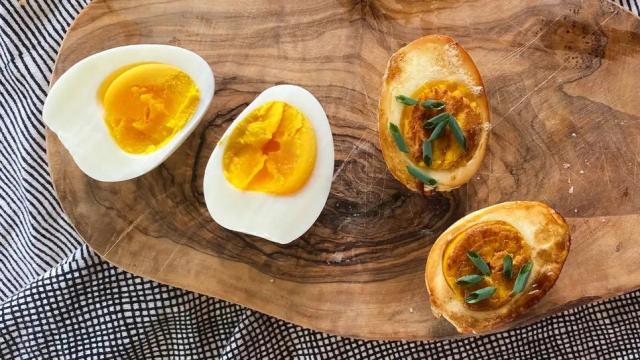Easter eggs are safe to eat, provided you follow a few safety rules (and don’t try to eat the plastic kind). If they weren’t, my mother would be dead: When my sisters and I were gorging ourselves on bunny-shaped chocolate, that woman was peeling and eating our dyed eggs, determined to not let a valuable protein source go to waste.
I’m sure she salted them — or at least I think she did — but she never did much to otherwise inject excitement into her egg eating. If you are happy eating unadorned hard boiled eggs like my mother, I’m happy for you. That sounds like a blissfully easy existence. If, like me, you cannot abide monotony, try one of these unexpected hardboiled egg consumption methods.
Fry them
These twice-cooked egg are surprisingly delightful, and perfect for moments when you want something warm and and savoury but only have access to slick, cold hardboiled eggs. Frying the eggs in brown butter gives them a deep, nutty flavour and crispy edges. They taste great on salads, toasts, and as the base for un-deviled eggs, and they’re easy to make:
Halve the egg, sprinkle it with a little salt, and melt some butter (about a tablespoon per egg) in a nonstick pan over medium-high heat. Once most of the foaming has subsided and the butter is just about to start browning, add the eggs, cut side down, and let them fry for about two minutes, until the are browned and crispy on the edges. Try to resist flipping back and forth, as that can lead to violent pops. (Moisture gets trapped under the flat side of the egg with each flip, causing a small explosion.) Once the cut side is browned, flip the egg and let the bottom get a little heat.
Wrap them in miso
I learned this manoeuvre while watching Samin Nosrat’s Salt, Fat, Acid, Heat. In the Salt episode, Samin meets up with Nancy Singleton Hachisu, and the two proceed to wrap hard-cooked eggs in miso, then let them hang out for four hours before gently removing the paste. The discovery changed my life, or at least the part of my life involving hardboiled eggs.
Instead of relying on the yolk to provide the flavour, the white is transformed from a utilitarian protein source into something deeply savoury and a little funky. It’s an exciting twist on the hardboiled egg, perfect for deviling or eating out of hand without additional seasoning. (If you’re worried about how much miso it takes to cure an egg, don’t; the miso can be re-used after curing.)
Make ramen eggs
One of the easiest says to make a hardboiled egg more interesting is to marinate it in an interesting liquid. My favourite is a mixture of mirin, soy sauce, and sake, along with a little brown sugar. The salty-sweet result makes a great snack, and is one of the easiest ways to add a little protein to a bowl of ramen. Just make the marinade as described here, let it cool completely, then peel and submerge the eggs in the mixture of flavorful liquids and let sit in the fridge overnight.

Leave a Reply
You must be logged in to post a comment.